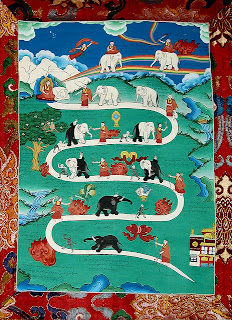May all beings have happiness and the causes of happiness; May all be free from sorrow and the causes of sorrow; May all never be separated from the sacred happiness which is sorrowless; And may all live in equanimity, without too much attachment and too much aversion, And live believing in the equality of all that lives.
Sunday, February 6, 2011
PATH OF SAMATHA MEDITATION
by Andy Weber
via http://www.snowlionpub.com/html/product_4639.htmlhttp://www.snowlionpub.com/html/product_4639.html
(Tibetan: Chi.nae) The painting here represents an aspiring meditator, who is following the path consisting of the stages of meditation that ends in the accomplishment of a calmly abiding mind and the beginning of the practice of insight meditation. At the bottom we see the practitioner, who holds a rope in one hand and a hook in the other, chasing after an elephant led by a monkey. The elephant represents the meditator's mind; a wild or untrained elephant can be dangerous and wreak enormous destruction, but once trained will obey and do hard work. The same holds true for the mind. Any suffering that we have now is due to the mind being like a wild, untrained elephant. The elephant also has very big footprints; these symbolize our mental defilements. If we work at improving our minds, inner peace will be the reward. From the suffering of the hells to the happiness of the Buddhas, it is the mind's activity that gives rise to them all.
At the start of the path the elephant is black, which represents dullness or sinking of the beginning meditator's mind. The monkey leading the elephant represents distraction. A monkey cannot keep quiet for a moment-it is always chattering or fidgeting and finds everything attractive. Just as the monkey is in front leading the elephant, our attention is distracted by sensory objects of taste, touch, sound, smell, and vision. These are symbolized by food, cloth, musical instruments, perfume, and a mirror. The person behind the elephant represents the meditator trying to train the mind. The rope in the meditator's hand is mindfulness and the hook is awareness. Using these two tools the meditator will try to tame and control his mind. Fire is shown at different points along the path to represent the energy necessary for concentration. Notice that the fire gradually decreases at each of the ten stages of calm abiding, as less energy is needed to concentrate. It will flare up again at the eleventh stage, when we start practising insight meditation.
In the beginning, just as the elephant following the monkey pays no attention to the person chasing after it, the practitioner has no control over his or her mind. In the second stage, the practitioner, who has almost caught up with the elephant, is able to throw the rope around the elephant's neck. It looks back; this is the third stage, where the mind can be restrained a little by mindfulness. Here a rabbit appears on the elephant's back, symbolizing subtle dullness, which might earlier have seemed to be a state of concentration, but now can be recognized for the harmful factor that it is. In these early stages we have to use mindfulness more than awareness.
At the fourth stage the elephant mind is more obedient, so it is less necessary to restrain it with the rope of mindfulness. By the fifth stage the elephant is being led by the rope and hook and the monkey is following behind. At this point we are not much disturbed by distracted attention; mostly we have to use awareness instead of mindfulness. In the painting, the sixth stage of practice is depicted with the elephant and the monkey both following obediently behind the practitioner, who does not even have to look back at them. This means that the practitioner does not have to focus continually on controlling the mind, and the absence of the rabbit shows that the subtle dullness, which appeared at the third stage, has now disappeared.
Upon reaching the seventh stage, the elephant can be left to follow of its own accord and the monkey departs; the practitioner has no more use for the rope and hook- distracted attention and dullness occur only occasionally and mildly. At the eighth stage the elephant has turned completely white and follows behind the practitioner; this shows that the mind is obedient and there is no sinking or scattering, although some energy is still needed to concentrate. At the ninth stage the practitioner can actually sit in meditation while the elephant sleeps peacefully nearby; at this point the mind can concentrate without effort for long periods of time- days, weeks, or even months. The tenth stage, where we see the meditator sitting on top of the elephant, signifies the real attainment of a calmly abiding mind. At the last, eleventh, stage, the meditator is sitting on the elephant's back holding a sword. At this point the practitioner begins a new kind of meditation called "higher vision," or insight meditation with which he seeks to realise the nature of reality.
Description provided courtesy of Norbulingka Institute.
Subscribe to:
Post Comments (Atom)

No comments:
Post a Comment